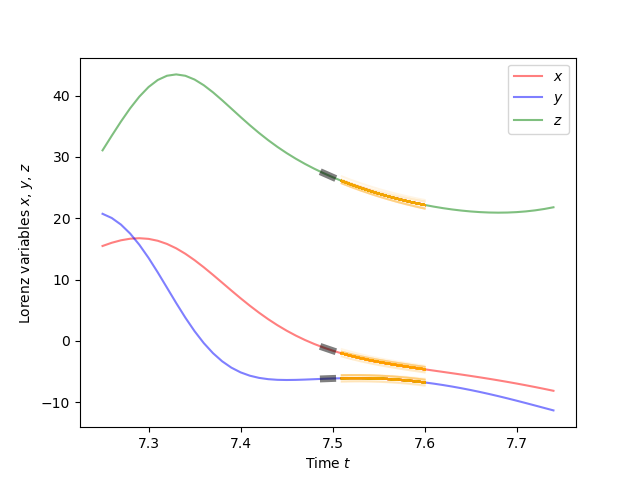Welcome to ruckus’s documentation!¶
ruckus is a Python package for building networks of reproducing kernel Hilbert spaces for machine learning.¶
Reproducing kernel Hilbert spaces [1] (RKHS’s, or, as I say it, “ruckuses”) form the mathematical bedrock of numerous machine learning techniques, from support vector machines and Gaussian processes to neural tangent kernels and random feature embeddings.
The classes and methods defined in this package are meant to be compatible with other popular machine learning APIs, in particular scikit-learn. The core object of the package is the RKHS class. An RKHS can be fit to data, can transform data by embedding it in the Hilbert space coordinates and can fit_functions using kernel ridge regression [2]. Averaging kernel embeddings over a sample of data points yields the kernel mean embedding of the data’s distribution [3], and the KernelHerd object can be applied to these embeddings to sample data using the kernel herding algorithm [4].
Specific RKHS implementations included are:
EigenRKHSwhich uses a singular value decomposition of a kernel of a specified kernel matrix, sped up with the Nyström method [5], to construct the embedding;RandomFourierRBFwhich uses Gaussian-sampled Fourier phase terms to construct embedding vectors [6];OneHotRKHSwhich embeds categorical data in probability space.
Further, RKHS instances can be composed into networks by use of the classes:
CompositeRKHSwhich allows for the function composition of embeddings to produce pipelines and deep kernels [7];ProductRKHSwhich allows for Hilbert spaces with tensor product structure, and includes methods for performing conditional density embeddings across factor spaces;DirectSumRKHSwhich allows for stacking RKHS embeddings along a concatenated axis,ConvolutionalRKHSwhich allows for using any RKHS as a convolutional filter onn-D data [8].
On top of this, several helper functions and classes are included to provide compatibility with cross-validation and model selection via scikit-learn.
N.B. ruckus is still very much in the alpha stage, and there may be errors that I have missed. If you find any, please don’t hesitate to bring them to my attention.
Installation¶
To install from pip, run
>>> pip install ruckus
To build from source, you can either download the zip or tarball directly, or clone the GitHub repository via
>>> git clone https://github.com/samlikesphysics/ruckus.git
Then run in the the same folder as setup.py:
>>> python setup.py build
>>> python -m pip install .
Dependencies¶
ruckus depends on the following packages:
Package |
Recommended version |
|---|---|
|
1.20.1 |
|
1.7.0 |
|
1.0.1 |
Example¶
Let us generate a dataset of the evolution of the Lorenz attractor:
import ruckus
import numpy as np
import matplotlib.pyplot as plt
def lorenz(n=100,s=10, r=28, b=2.667, dt=0.01):
xs = np.empty(n + 1)
ys = np.empty(n + 1)
zs = np.empty(n + 1)
xs[0], ys[0], zs[0] = (0., 1., 1.05)
for i in range(1,n+1):
xs[i] = xs[i-1] + (s*(ys[i-1] - xs[i-1]))*dt
ys[i] = ys[i-1] + (r*xs[i-1] - ys[i-1] - xs[i-1]*zs[i-1])*dt
zs[i] = zs[i-1] + (xs[i-1]*ys[i-1] - b*zs[i-1])*dt
return np.concatenate([xs[None,:],ys[None,:],zs[None,:]]).T
X = lorenz(10000)
We wish to learn how any window of 10 timesteps may be predicted from the preceding 2 timesteps. To do this, we would set up a convolutional filter which takes blocks of length 12, and uses an RKHS to embed the length-2 past blocks and length-10 future blocks separately. We could use these embeddings in a product space to learn their joint distribution and compute the conditional distribution of the future window, conditioned on the past window. This can be done using the simple code:
Lp = 2
Lf = 10
beta=0.5
conv_net = ruckus.convolution.ConvolutionalRKHS(
# Convolution window includes past and future
window_shape=(Lp+Lf,),
# Setup filter RKHS
rkhs=ruckus.ProductRKHS([
# Use Random Fourier Features
ruckus.RandomFourierRBF(
gamma=0.1,n_components=1024,
# Take all 3 variables and past Lp timesteps
take=(np.array([[0],[1],[2]]),
np.array([list(range(Lp))])),
# Exponentially punish further-past points
filter=np.array([[beta**k for k in range(Lp)][::-1]]*3),
copy_X=False
),
# Use Random Fourier Features
ruckus.RandomFourierRBF(
gamma=0.1,n_components=1024,
# Take all 3 variables and future Lf timesteps
take=(np.array([[0],[1],[2]]),
np.array([list(range(Lp,Lp+Lf))])),
# Exponentially punish further-future points
filter=np.array([[beta**k for k in range(Lf)]]*3),
copy_X=False
),
],copy_X=False)
)
# Fit convolutional kernel network on data
conv_net.fit(X)
# Extract conditional distribution
conditional_map, future_space = conv_net.rkhs.conditional([0],[1],alpha=1e-6)
Let’s judge our work: for any time index j we can take the preceding two timesteps, use conditional_map to predict the embedding of the future ten timesteps, and generate forecasts using KernelHerd.
j = 750
dt = 0.01
rng = [j-25,j+25]
n_samples = 100
colors = ['r','b','g']
names = [r'$x$',r'$y$',r'$z$']
for k in range(3):
plt.plot(np.arange(rng[0],rng[1])*dt,X[rng[0]:rng[1],k],alpha=0.5,c=colors[k],label=names[k])
plt.plot(np.arange(j-Lp+1,j+1)*dt,X[j-Lp+1:j+1,k],c='k',linewidth=5,alpha=0.5)
samples = np.array(list(ruckus.sampling.KernelHerd(
conditional_map.predict(X[j-Lp+1:j+Lf+1,].T[None])[0],
future_space,
size=n_samples
)))
for s in samples:
for k in range(3):
plt.plot(np.arange(j+1,j+Lf+1)*dt,list(s[k][Lp:]),alpha=0.1,c='orange')
plt.ylabel(r'Lorenz variables $x$, $y$, $z$')
plt.xlabel(r'Time $t$')
plt.legend()
plt.savefig('Lorenz.png')
plt.show()

Naturally, this is not quite the best way to “learn” the Lorenz attractor; better methods would use our conditional embeddings to extract information about the dynamical system and then use that knowledge to make forecasts. This can also be done using the tools in ruckus - but is left as an exercise to the reader!
References¶
Aronszajn, N. “Theory of reproducing kernels.” Trans. Amer. Math. Soc. 68 (1950), 337-404.
Murphy, K. P. “Machine Learning: A Probabilistic Perspective”, The MIT Press. chapter 14.4.3, pp. 492-493